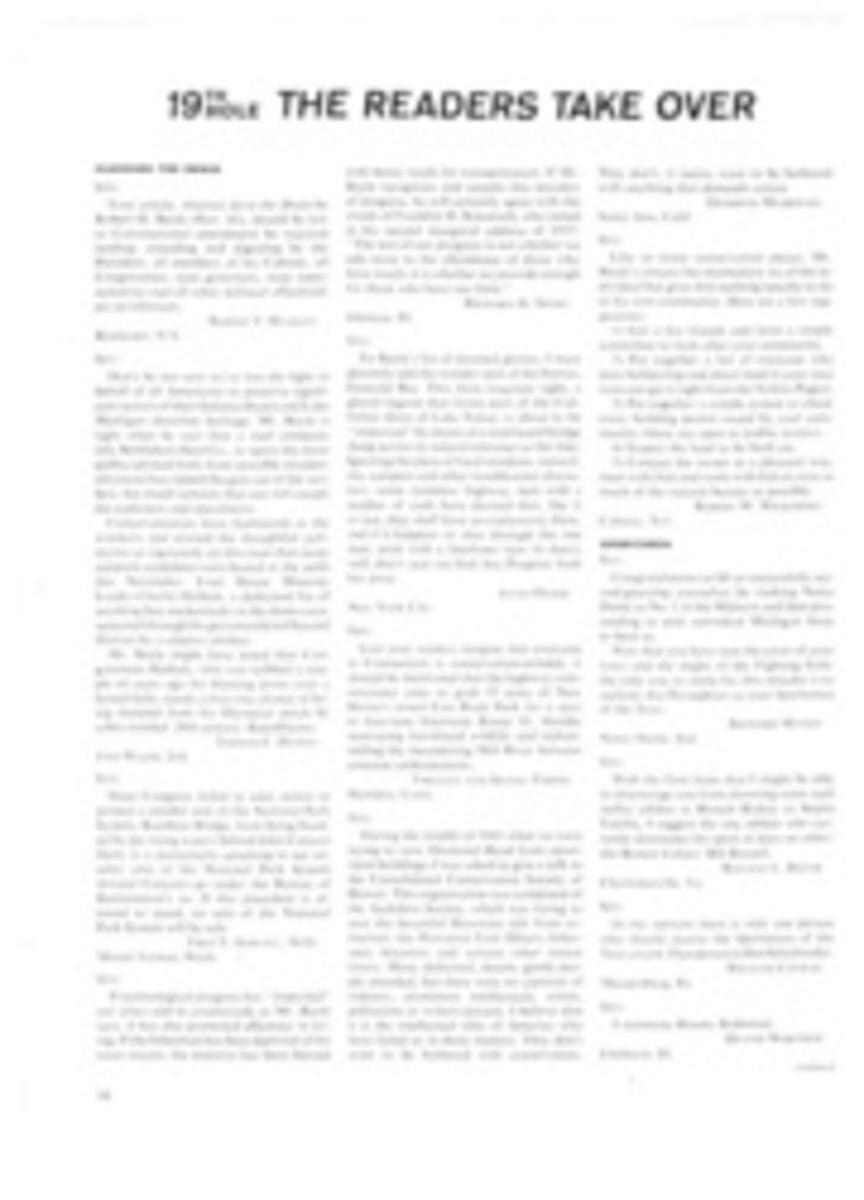
Duck shooting on Maine's icy ledges
From June through Labor Day, Captain Ransom Pingree Kelley, resplendent in blue and white uniform and white officer's cap, sails out of Maine's Boothbay Harbor, Christmas Cove and Pemaquid Beach with boatloads of tourists in bathing suits and Bermuda shorts. His maxim for the tourists is casual: "Experience the sense and feel of a variety of water.... Leave when you like." But on a chilly November morning, with the thermometer at 10°, Ransom Kelley, duck guide, in rumpled wool shirt and pants, tentlike camouflage parka and fur-lined hat, backs the Magnum II out of her slip at a time that he likes—4:30 a.m.—and heads out of the harbor for the offshore ledges.
Kelley is Maine's biggest (6 feet, 275 pounds) and most erudite seabirder. Harvard-educated and a gunner ever since he first shot over live goose and duck decoys on Massachusetts' Duxbury Beach, Kelley happily relinquished Boston society when he was 20 and moved to Maine. In the 31 years since, he has sailed into every harbor on the Maine coast, raised crops and cattle, guided on Merrymeeting Bay, won the state skeet championship, married the attractive daughter of an old Maine market hunter and guide (it was kind of a shotgun wedding: they went duck shooting before and after the ceremony), sold boats and finally settled into the excursion-boat business.
A huge man whose girth is exceeded only by his agility, Kelley is one of very few duck guides left who can scull a shallow-draft boat right into the middle of a raft of ducks in an open bay. He is also the only duck guide in New England who takes shooters out to the offshore ledges in a 60-foot excursion boat fitted out with bunks, heaters, a refrigerator full of steaks and enough duck decoys to fill a large dory.
Riding in the wake of the Magnum II on ice-caked towlines are a Boston Whaler and the Canard Noir, a 20-foot outboard-powered duck boat that looks more like the Monitor than a cleverly designed floating blind. Kelley steers through the gloom, looking at his charts and munching on a stale chocolate doughnut. Peg and Bess, his Labradors, snuggle up against him, wet noses quivering, eyes trained on the doughnut.
"Afraid I'll have to leave you girls on board today," Kelley says to his dogs. "We'll pick up the birds with the motor-boat. It'll be choppy out there, and I don't want you to be chasing diving cripples around all morning and get battered against the ledge by the waves."
Eiders, Kelley explains, can carry off enough shot to sink most ducks. Even when hit with a 12-gauge magnum load, well-placed, most eiders require a second shot after they strike the water. Those that manage to dive before the finishing shot is fired lead dogs on a wild chase. Sometimes they even get help from seals. Not long ago, Kelley sent a dog after a crippled eider. "All of a sudden she was surrounded by 25 big seals. They herded her right back onto the ledge. Never bit her, but she sure was all atremble. Scared her half to death."
The eiders—American and Northern—are the largest of the North American ducks, and the hardiest. Long after other waterfowl have been driven down the Atlantic coast by freezing winds, snow and subzero temperatures, huge rafts of eiders ride the heavy swells offshore, diving to 60 feet and deeper for blue mussels, snails and other mollusks and crustaceans which they grind up with powerful gizzards.
While most duck shooters snuggle deeper under the blankets, the Maine seabirder gets up at 4 a.m., drives his boat through swells that wash over the decks and turn them into sheets of ice, sets his trawl line of decoys, anchors in the lee of a ledge and covers his boat with rockweed. There, buffeted by the wind and soaked with freezing spray, he suffers and waits for eiders to come in from the sea to feed. The more impetuous hunter may even ride the swells onto the ledge, cover up his boat and wedge himself into a cold, wet barnacle-encrusted crevice. Not surprisingly, few duck shooters will subject themselves to such tortures, even for a daily bag limit of seven ducks. But with Kelley it is possible to "go eiderin' " not only in comfort but in real style.
In the first pink light of a chilly dawn a ledge called The Cuckolds looms to starboard. Kelley slides back a window in the pilothouse. "Look right to windward of that ledge," he says, pointing to a raft of perhaps 1,000 eiders bobbing in the chop. As the boat moves closer, the rearguard of eiders, snowy-white and black drakes and drab, brown hens patters clumsily across the surface, their wings, set well astern on their bodies, revving up until finally they get up above the waves. The rest of the raft follows until they are all flying, a twisting string of ducks half a mile long. By the time the decoy trawl is set and the Canard Noir is anchored 35 yards away against the ledge, small flocks of eiders, flushed by lobster boats, begin to fly back in.
Inside the blind, Kelley toasts his feet in front of a kerosene lantern, sips a cup of tea and peers out over the high, hinged sides. A flock of 25 eiders banks into the wind and heads for the decoys. For a moment they are lost to view in the wave troughs. Then suddenly they gain altitude, pass over the decoys and hook around. Feet down and wings set, they glide in.
"Let them land," Kelley whispers. "They'll add some life to the decoys." The ducks skid in with a splash and immediately begin to dive for mussels. Then another flock swings in.
"Now," Kelley yells, pushing down the sides of the Canard Noir. West and up and shoot. Three eiders drop heavily into the decoys. "Reload," Kelley yells. Suddenly the water seems to erupt with ducks as the first flock zooms up from the bottom, bursting through the surface like Polaris missiles. Kelley fires two deliberate shots, and two white males drop.
"Two cripples," he says, reloading his automatic. "Clean them up."
Despite their gregarious nature, eiders become quickly educated to the sound of gunfire. Although they will invariably swing over a realistic set of decoys, they will not always drop into them, and much of the shooting will be at passing birds.
"Eiders look as big and as slow as balloons," says Kelley, "but they're deceiving. You start shooting and they ring down for more steam—they've got plenty in reserve. It can be a mighty humbling experience."
Expending considerable ammunition, six or eight shooters can get their limits, often from the same ledge, by midmorning—if not through shooting skill, then by the sheer numbers of eiders swinging over their decoys. The eider shooter may also get some good shooting at coots or old squaws and on rare occasions at harlequins, as beautifully colored as the freshwater wood duck.
The morning's ledge gunning is only part of Ransom Kelley's unique operation. Atlantic Flyway shooters this year are allowed a daily bag limit of three diving or puddle ducks. With any luck at all, Kelley will take care of that by sculling shooters down on rafts of old squaws, whistlers, bluebills, buffleheads and black ducks on the inland estuaries, bays and tidal rivers. His scull, or sneak boat, is 16 feet long, 40 inches wide and so low to the water that when camouflaged with snow, marsh grass or rock-weed it looks like nothing more than a chunk of flotsam moving along with the tide. The gunner lies on his back in the bow until Kelley yells for him to sit up and shoot. The first time he pops up, he very likely will freeze at the shock of hundreds of ducks jumping into the air all around him.
If Kelley finds this a rather irritating quality in a shooter, he has good reason. Wedged tightly in the stern compartment (often with Peg or Bess squirming between his legs and whining softly at the smells and the gabbling of nearby ducks), Kelley is perspiring profusely. Two hours of sculling on a raft of ducks moving with the tide is not unusual, and more than once the ash oar has snapped in his hands from the strain of pushing more than 1,000 pounds of boat, men, dogs, guns and ammunition through the water.
"A good time to scull ducks," Kelley says, "is late in the fall when the inland waters are buttoned up. You scull up while they are feeding—during the last two hours of flood, when the advancing water melts the ice on the marsh, and the first two hours of the ebb, before the marsh freezes up again."
In braver moments Kelley rigs his sneak boat with a canvas spray cover and sculls Canada geese offshore, bucking winds that sometimes hit 30 knots. "It's quite comical," Kelley says. "You spot the geese from the big boat, take a compass course on them and then play hide-and-seek in the waves. You are sculling like hell to reach them, and suddenly you are riding down the face of a wave and the geese are down in the trough of the same wave, looking right in at you. Then you try to shoot at them and watch the waves at the same time.
"Sculling," he warns, "is fast becoming a lost art, because today's bag limits are completely unrealistic. But they could be made realistic, if the price of the federal duck stamp was raised and the extra money used for more sanctuaries and stricter law enforcement to increase diving and puddle duck populations. With today's gunning pressure Canada can't produce enough ducks."
Sea ducks are doing much better. The worst threat to the nesting eiders on Maine's offshore islands is the black-backed gull, or minister bird. The minister pierces eider eggs and sucks out the embryos, and it kills a number of fledglings by plucking them right out of the air or beating them to death in the water with its wings. At one time the Fish and Wildlife Service successfully kept the minister population down by spraying their eggs with an oil solution, which clogged the breathing pores of the shells and killed the embryos inside. The gulls sat on the eggs until it was too late to renest. Unaccountably, the experiment was stopped in 1950, and the ministers are making a comeback.
But there are still more than enough eiders and other sea ducks, and biologists say they could stand greater gunning, thereby taking some of the pressure off other ducks which are over-gunned. But while the frigid weather and the thought of having to endure it on an exposed rock ledge in the ocean turns many a shooter away, the sea duck's tough, fishy meat discourages others. "There are ways to cook sea birds," Kelley insists. "You can skin the breasts, soak them in water with salt and soda to get out the fishy odor and then sauté them or use them in a stew." Or you can give them away, preferably to some innocent friend with a mild disposition.
PHOTO
KELLEY AND FRIEND TAKE THE "MAGNUM II" OUT OF BOOTHBAY HARBOR

